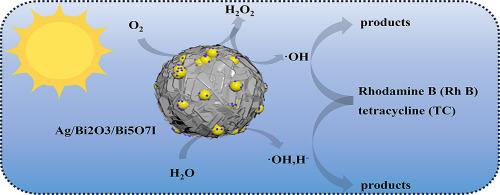II-scheme heterojunction of photocatalyst for efficient degradation of antibiotics and dyes under visible-light irradiation
IF 5.4
3区 化学
Q1 CHEMISTRY, INORGANIC & NUCLEAR
引用次数: 0
Abstract
A novel II-scheme heterojunction composite Ag/Bi2O3/Bi5O7I (ABMBOI) was successfully synthesized through a combined solvothermal-calcination strategy. S-Scheme heterojunctions were prepared and strong interfacial electronic coupling was formed. The phase composition, microstructure, and optoelectronic properties of the as-prepared materials were systematically characterized by A series of characteristic means. The optimized ABMBOI33 composite (with Ag/Bi-MOF molar ratio of 1:1 and ABM3/Bi5O7I mass ratio of 1:3) demonstrated exceptional photocatalytic performance under visible light irradiation, achieving degradation efficiency of 96.8 % for RhodamineB (RhB) and 84.4 % for tetracycline (TC) within 70 min. This significant enhancement may be attributed to three synergistic effects: surface plasmon resonance (SPR) effect induced by Ag nanoparticles extending visible light absorption, the increase of active sites and the efficient charge separation enabled by the construction of II-scheme heterojunction architecture. Radical trapping experiments combined with electron spin resonance (ESR) analysis revealed that h+, 1O2 and ·OH served as the predominant reactive species in the degradation process of RhB, while h+ and ·OH were identified as the primary contributors to TC decomposition. Furthermore, the effects of common inorganic anions, solution pH value and catalyst dosage on RhB degradation have also been systematically investigated.

可见光下高效降解抗生素和染料的异质结光催化剂
采用溶剂-热-煅烧相结合的方法成功合成了一种新型ii型异质结复合材料Ag/Bi2O3/Bi5O7I (ABMBOI)。制备了s型异质结,形成了强界面电子耦合。通过一系列表征手段对制备的材料的相组成、微观结构和光电性能进行了系统表征。优化后的ABMBOI33复合材料(Ag/Bi-MOF摩尔比为1:1,ABM3/Bi5O7I质量比为1:3)在可见光照射下表现出优异的光催化性能,在70 min内对罗丹明b (RhB)和四环素(TC)的降解效率分别达到96.8%和84.4%。这种显著的增强可能归因于三个协同效应:银纳米粒子引起的表面等离子体共振(SPR)效应延长了可见光吸收,活性位点的增加以及ii型异质结结构的构建实现了有效的电荷分离。自由基捕获实验结合电子自旋共振(ESR)分析表明,h+、1O2和·OH是RhB降解过程中的主要反应物质,而h+和·OH是TC分解的主要物质。此外,还系统地研究了常见无机阴离子、溶液pH值和催化剂用量对RhB降解的影响。
本文章由计算机程序翻译,如有差异,请以英文原文为准。
求助全文
约1分钟内获得全文
求助全文
来源期刊

Inorganic Chemistry Communications
化学-无机化学与核化学
CiteScore
5.50
自引率
7.90%
发文量
1013
审稿时长
53 days
期刊介绍:
Launched in January 1998, Inorganic Chemistry Communications is an international journal dedicated to the rapid publication of short communications in the major areas of inorganic, organometallic and supramolecular chemistry. Topics include synthetic and reaction chemistry, kinetics and mechanisms of reactions, bioinorganic chemistry, photochemistry and the use of metal and organometallic compounds in stoichiometric and catalytic synthesis or organic compounds.
 求助内容:
求助内容: 应助结果提醒方式:
应助结果提醒方式:


